Braid theory
The branch of topology and algebra concerned with braids, the groups formed by their equivalence classes and various generalizations of these groups [1].
A braid on  strings is an object consisting of two parallel planes
strings is an object consisting of two parallel planes  and
and  in three-dimensional space
in three-dimensional space  , containing two ordered sets of points
, containing two ordered sets of points  and
and  , and of
, and of  simple non-intersecting arcs
simple non-intersecting arcs  , intersecting each parallel plane
, intersecting each parallel plane  between
between  and
and  exactly once and joining the points
exactly once and joining the points  to
to  ,
,  . It is assumed that the
. It is assumed that the  's lie on a straight line
's lie on a straight line  in
in  and the
and the  's on a straight line
's on a straight line  in
in  parallel to
parallel to  ; moreover,
; moreover,  lies beneath
lies beneath  for each
for each  (see Fig. a). Braids can be represented in the projection on the plane passing through
(see Fig. a). Braids can be represented in the projection on the plane passing through  and
and  ; this projection can be brought into general position in such a way that there are only finitely many double points, each two of which lie at different levels, and the intersections are transversal.
; this projection can be brought into general position in such a way that there are only finitely many double points, each two of which lie at different levels, and the intersections are transversal.
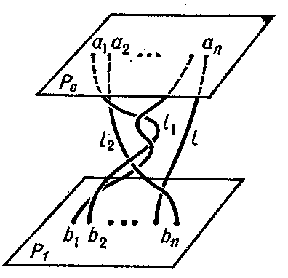
Figure: b017470a
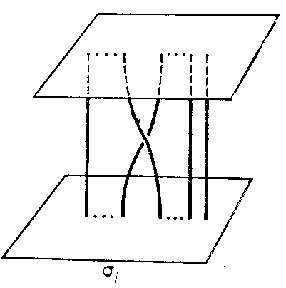
Figure: b017470b
The string  of a braid
of a braid  joins
joins  to
to  and so defines a permutation
and so defines a permutation
 |
If this is the identity permutation,  is called a coloured (or pure) braid. The transposition
is called a coloured (or pure) braid. The transposition  corresponds to a simple braid
corresponds to a simple braid  (see Fig. b).
(see Fig. b).
On the set of all braids on  strings with fixed
strings with fixed  ,
,  ,
,  ,
,  , one introduces the equivalence relation defined by homeomorphisms
, one introduces the equivalence relation defined by homeomorphisms  , where
, where  is the region between
is the region between  and
and  , which reduce to the identity on
, which reduce to the identity on  ; it may be assumed that
; it may be assumed that  . Braids
. Braids  and
and  are equivalent if there exists a homeomorphism with the above properties such that
are equivalent if there exists a homeomorphism with the above properties such that  .
.
The equivalence classes — which are still called braids — form the braid group  with respect to the operation defined as follows. Place a copy
with respect to the operation defined as follows. Place a copy  of the domain
of the domain  above another copy
above another copy  , in such a way that
, in such a way that  coincides with
coincides with  ,
,  with
with  , and then compress
, and then compress  to half its "height" . The images of the braids
to half its "height" . The images of the braids  and
and  produce a braid
produce a braid  , with string
, with string  obtained by extending
obtained by extending  with
with  , where
, where  . The identity braid is the equivalence class containing the braid with
. The identity braid is the equivalence class containing the braid with  parallel segments; the inverse
parallel segments; the inverse  of a braid
of a braid  is defined by reflection in the plane
is defined by reflection in the plane  . For the condition
. For the condition  see Fig. c.
see Fig. c.
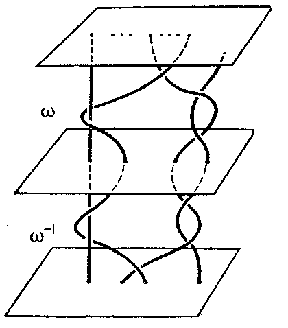
Figure: b017470c
The mapping  defines an epimorphism of
defines an epimorphism of  onto the group
onto the group  of permutations of
of permutations of  elements, the kernel of this epimorphism is the subgroup
elements, the kernel of this epimorphism is the subgroup  of all pure braids, so that one has an exact sequence
of all pure braids, so that one has an exact sequence
 |
The braid group  has two principal interpretations. The first, as a configuration space, is obtained by identifying the planes
has two principal interpretations. The first, as a configuration space, is obtained by identifying the planes  via vertical projection onto
via vertical projection onto  , under which the images of the points
, under which the images of the points  , considered as
, considered as  varies from 0 to 1, form the trace of an isotopy
varies from 0 to 1, form the trace of an isotopy  of the set
of the set  along
along  ; one has
; one has  . Consider the space of unordered sequences
. Consider the space of unordered sequences  of
of  pairwise distinct points of the plane; then each braid corresponds in one-to-one fashion to a class of homotopy loops in this space, and one has an isomorphism
pairwise distinct points of the plane; then each braid corresponds in one-to-one fashion to a class of homotopy loops in this space, and one has an isomorphism
 |
For pure braids one has an analogously constructed isomorphism
 |
where  is the space of ordered sequences of
is the space of ordered sequences of  distinct points of the plane, so that
distinct points of the plane, so that  can be identified with the subgroup corresponding to the covering
can be identified with the subgroup corresponding to the covering
 |
The second interpretation, as a homeotopy group, is obtained by extending the isotopy  to an isotopy
to an isotopy  of the plane
of the plane  that coincides with the identity outside some disc, and such that
that coincides with the identity outside some disc, and such that  . For each
. For each  , two such extensions differ by a homeomorphism which is the identity at the points
, two such extensions differ by a homeomorphism which is the identity at the points  . A braid uniquely determines a component of the space of homeomorphisms
. A braid uniquely determines a component of the space of homeomorphisms  of the plane which map the set
of the plane which map the set  onto itself, and one has an isomorphism
onto itself, and one has an isomorphism
 |
To each homeomorphism  corresponds an automorphism of the free group of rank
corresponds an automorphism of the free group of rank 
 , defined up to an inner automorphism, which in turn yields a homomorphism
, defined up to an inner automorphism, which in turn yields a homomorphism  . The elements of the image are called braid automorphisms of the free group. In particular, corresponding to the braid
. The elements of the image are called braid automorphisms of the free group. In particular, corresponding to the braid  one has an automorphism
one has an automorphism
 |
if  (
( is a set of generators of
is a set of generators of  ). Any braid automorphism
). Any braid automorphism  possesses the following properties:
possesses the following properties:
 |
up to an inner automorphism (for the meaning of  , see below); these properties characterize braid automorphisms.
, see below); these properties characterize braid automorphisms.
The braids  , are the generators of the group
, are the generators of the group  , i.e.
, i.e.  , with
, with
 | (1) |
It turns out that (1) is a presentation of  (see Fig. d).
(see Fig. d).
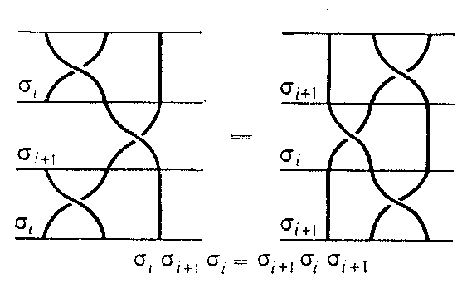
Figure: b017470d
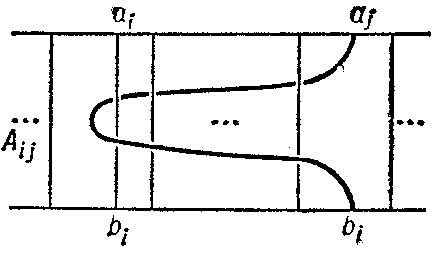
Figure: b017470e
There exists a splitting exact sequence (obtained from the locally trivial fibration  with fibre
with fibre  ):
):
 |
which leads to the normal series
 |
with free factors  , where
, where  has a "component"
has a "component"  isomorphic to
isomorphic to  . Each element
. Each element  can be expressed uniquely in the form
can be expressed uniquely in the form
 |
where  is a selected representative for
is a selected representative for  in
in  and
and  . The reduction of a braid to this form is known as its dressing. This solves the word (identity) problem in
. The reduction of a braid to this form is known as its dressing. This solves the word (identity) problem in  .
.
A presentation of  is as follows: generators (see Fig. e):
is as follows: generators (see Fig. e):
 |
relations:
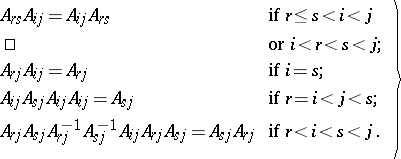 | (2) |
This presentation may be obtained as a presentation of the kernel of the natural homomorphism into  of the abstract group
of the abstract group  defined by the presentation (1) with the aid of the Schreier system
defined by the presentation (1) with the aid of the Schreier system  ,
,  , where
, where  .
.
The centre of  is the infinite cyclic group generated by the element
is the infinite cyclic group generated by the element  . The commutator group
. The commutator group  coincides with
coincides with  for
for  ;
;  is isomorphic to the free group of rank 2, and
is isomorphic to the free group of rank 2, and  is isomorphic to semi-direct product of two such groups. The quotient group modulo the commutator subgroup is an infinite cyclic group, generated by the images of
is isomorphic to semi-direct product of two such groups. The quotient group modulo the commutator subgroup is an infinite cyclic group, generated by the images of  . There are no elements of finite order in
. There are no elements of finite order in  . The group
. The group  is mapped onto itself by endomorphisms with non-Abelian image. In particular,
is mapped onto itself by endomorphisms with non-Abelian image. In particular,  is a fully-characteristic subgroup of
is a fully-characteristic subgroup of  , and also of
, and also of  (see [15]).
(see [15]).
Solving the conjugacy problem in  is much more complicated than solving the word problem. There is a unique Garside normal form of a braid,
is much more complicated than solving the word problem. There is a unique Garside normal form of a braid,  , where
, where  is what is known as a Garside element and
is what is known as a Garside element and  is a positive braid, i.e. a braid the representation of which in terms of the elements
is a positive braid, i.e. a braid the representation of which in terms of the elements  has positive indices. With any braid
has positive indices. With any braid  one can associate, using finitely many operations depending on
one can associate, using finitely many operations depending on  (conjugation with certain elements, choice of elements of maximum degree, etc.), a certain set of words
(conjugation with certain elements, choice of elements of maximum degree, etc.), a certain set of words  , from which one selects a word in normal form
, from which one selects a word in normal form  with minimal
with minimal  . This is a so-called upper form of the braid
. This is a so-called upper form of the braid  . It turns out that two braids are conjugate if and only if they have a same upper form (see [7]).
. It turns out that two braids are conjugate if and only if they have a same upper form (see [7]).
The Burau representation of the braid group  in the group of matrices over the ring of polynomials in one variable with integer coefficients is defined by the correspondence
in the group of matrices over the ring of polynomials in one variable with integer coefficients is defined by the correspondence
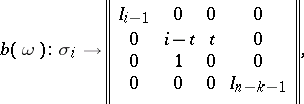 |
where  is the identity matrix of order
is the identity matrix of order  . The matrix
. The matrix  is the reduced Alexander matrix (see Alexander invariants) of the link obtained by closing the braid
is the reduced Alexander matrix (see Alexander invariants) of the link obtained by closing the braid  (see below). For a pure braid one obtains the full Alexander matrix from the analogous Gassner matrix. The problem of whether these representations are faithful is still (1982) unsolved (see [2]).
(see below). For a pure braid one obtains the full Alexander matrix from the analogous Gassner matrix. The problem of whether these representations are faithful is still (1982) unsolved (see [2]).
The fact that the spaces  and
and  are aspherical makes it possible to evaluate the homology of braid groups.
are aspherical makes it possible to evaluate the homology of braid groups.
The homology of  (see [16]). Homologically,
(see [16]). Homologically,  coincides with the product of unions of circles in which the number of circles runs from one through
coincides with the product of unions of circles in which the number of circles runs from one through  . The homology ring is isomorphic to the exterior graded ring generated by the one-dimensional elements
. The homology ring is isomorphic to the exterior graded ring generated by the one-dimensional elements  ,
,  , with relations
, with relations
 |
As  one can take the forms
one can take the forms
 |
corresponding to passage along the diagonals  .
.
The homology of  (see [8], [12]). The homomorphism
(see [8], [12]). The homomorphism  can be extended to an imbedding
can be extended to an imbedding  ; the induced homomorphism of cohomology spaces
; the induced homomorphism of cohomology spaces  is epimorphic, i.e. the cohomology spaces
is epimorphic, i.e. the cohomology spaces  of the group
of the group  generated by the Stiefel–Whitney classes.
generated by the Stiefel–Whitney classes.
There is a natural mapping of  into
into  , the two-fold loop space of
, the two-fold loop space of  , i.e. the space of spheroids
, i.e. the space of spheroids  (choose small discs about
(choose small discs about  points, then map these discs canonically with degree 1 into a sphere, mapping the entire complement onto a point). This mapping (see [14]) establishes a homology equivalence of the limit space
points, then map these discs canonically with degree 1 into a sphere, mapping the entire complement onto a point). This mapping (see [14]) establishes a homology equivalence of the limit space  and
and  (the subscript indicates that one chooses the component of spheroids of degree 0). As to the unstable homology groups of
(the subscript indicates that one chooses the component of spheroids of degree 0). As to the unstable homology groups of  , it has been proved [16] that they are finite, stabilize at height
, it has been proved [16] that they are finite, stabilize at height  and satisfy the recurrence relation
and satisfy the recurrence relation  . There is a description of the calculation of these groups [17].
. There is a description of the calculation of these groups [17].
Applications and generalizations.
1) A closed braid is a link (an  -component knot) in
-component knot) in  each component of which transversally cuts out half-planes bounded by the same straight line: the axis
each component of which transversally cuts out half-planes bounded by the same straight line: the axis  of the closed braid (see Fig. f).
of the closed braid (see Fig. f).
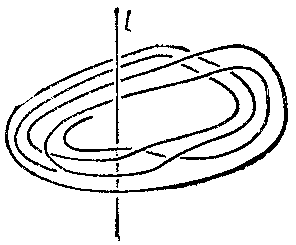
Figure: b017470f
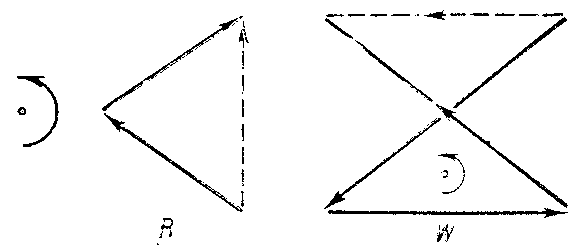
Figure: b017470g
A braid  generates a closed braid
generates a closed braid  (the closure of
(the closure of  ) in the following way. Consider a cylinder with bases on
) in the following way. Consider a cylinder with bases on  and
and  , the interior of which contains
, the interior of which contains  . Let this cylinder be deformed in
. Let this cylinder be deformed in  so that its elements become circles with centres on
so that its elements become circles with centres on  , its bases coincide and each point
, its bases coincide and each point  coincides with
coincides with  . Then
. Then  is the union of the strings
is the union of the strings  . Conversely, every link in
. Conversely, every link in  can be represented by a closed braid. To equivalent braids correspond isotopic links and, moreover, conjugate braids yield isotopic links. The converse is false, since a link may be represented by braids with different numbers of strings. In addition, the braids
can be represented by a closed braid. To equivalent braids correspond isotopic links and, moreover, conjugate braids yield isotopic links. The converse is false, since a link may be represented by braids with different numbers of strings. In addition, the braids  and
and  are not conjugate in
are not conjugate in  , but they correspond to isotopic links. If two closed braids are equivalent as links, they can be derived from one another by a chain of elementary transformations of two types (see Fig. g). These operations are interpreted in terms of presentations of the link group, thus yielding a reformulation of the isotopy problem for links as a question concerning the system of groups
, but they correspond to isotopic links. If two closed braids are equivalent as links, they can be derived from one another by a chain of elementary transformations of two types (see Fig. g). These operations are interpreted in terms of presentations of the link group, thus yielding a reformulation of the isotopy problem for links as a question concerning the system of groups  . A presentation of the link group of
. A presentation of the link group of  has the form
has the form
 |
where the relations are defined by braid automorphisms  . Conversely, any such relation defines a braid.
. Conversely, any such relation defines a braid.
2) If one cuts a surface of genus  with
with  non-intersecting cuts so as to obtain a sphere with
non-intersecting cuts so as to obtain a sphere with  holes, then the homeomorphisms of this sphere with holes that fix points on the edges of the holes define homeomorphisms of the surface which fix the cuts and are themselves defined up to isotopy by the elements of the group
holes, then the homeomorphisms of this sphere with holes that fix points on the edges of the holes define homeomorphisms of the surface which fix the cuts and are themselves defined up to isotopy by the elements of the group  . This yields a representation of the braid group in the homotopy group of the surface. Similarly one constructs a representation of
. This yields a representation of the braid group in the homotopy group of the surface. Similarly one constructs a representation of  . These representations are used in studying Heegaard diagrams of three-dimensional manifolds (cf. Three-dimensional manifold).
. These representations are used in studying Heegaard diagrams of three-dimensional manifolds (cf. Three-dimensional manifold).
3) By identifying  with the complex plane
with the complex plane  and associating with any unordered set of
and associating with any unordered set of  points in the plane a polynomial of degree
points in the plane a polynomial of degree  having these points as roots, one can identify
having these points as roots, one can identify  with the space of polynomials with non-zero discriminants. This has made it possible to obtain several results concerning the non-representability of algebraic functions by superpositions of functions in fewer variables (see [16]).
with the space of polynomials with non-zero discriminants. This has made it possible to obtain several results concerning the non-representability of algebraic functions by superpositions of functions in fewer variables (see [16]).
4) Configuration spaces for arbitrary spaces  are defined in analogy with
are defined in analogy with  and
and  , with
, with  replaced by
replaced by  . The fundamental groups of these spaces,
. The fundamental groups of these spaces,  and
and  , are called the braid group of the space
, are called the braid group of the space  and the pure braid group of the space
and the pure braid group of the space  , respectively. For a manifold
, respectively. For a manifold  of dimension exceeding 2,
of dimension exceeding 2,  , and this group is of no interest. For two-dimensional manifolds, one has a natural imbedding of
, and this group is of no interest. For two-dimensional manifolds, one has a natural imbedding of  and
and  into
into  and
and  induced by an imbedding
induced by an imbedding  . If
. If  is neither a sphere nor a projective space, one obtains an exact sequence
is neither a sphere nor a projective space, one obtains an exact sequence
 |
for the sphere, the homomorphism  is an epimorphism, obtained by adding to (1) the single relation
is an epimorphism, obtained by adding to (1) the single relation
 |
5) If  is a
is a  -sheeted covering, then
-sheeted covering, then  , where
, where  is a loop in
is a loop in  , is a loop in the configuration space
, is a loop in the configuration space  , and this defines a homomorphism
, and this defines a homomorphism  which strengthens the monodromy of the covering and has applications in algebraic geometry.
which strengthens the monodromy of the covering and has applications in algebraic geometry.
6) Let  be the complexification of a real vector space
be the complexification of a real vector space  and let
and let  be a finite irreducible group generated by reflections acting in
be a finite irreducible group generated by reflections acting in  (hence also in
(hence also in  ). Let
). Let  be generating reflections in the planes
be generating reflections in the planes  and let
and let  be their union. Finally, let
be their union. Finally, let  and let
and let  be the quotient space. The groups
be the quotient space. The groups  and
and  are called Brieskorn groups and constitute natural generalizations of
are called Brieskorn groups and constitute natural generalizations of  and
and  . If
. If  , then
, then  has a presentation of the form
has a presentation of the form
 |
where the number of factors on each side is equal to  (
( here corresponds to a Weyl chamber). It has been proved for these groups that
here corresponds to a Weyl chamber). It has been proved for these groups that  and
and  are spaces of type
are spaces of type  , and the conjugacy problem has been solved. The spaces
, and the conjugacy problem has been solved. The spaces  appear in algebraic geometry as complements to the discriminant of versal deformations of rational singularities (see [12], [13]).
appear in algebraic geometry as complements to the discriminant of versal deformations of rational singularities (see [12], [13]).
References
| [1] | E. Artin, "Theory of braids" Ann. of Math. , 48 (1947) pp. 643–649 MR0019087 Zbl 0030.17703 |
| [2] | J.S. Birman, "Braids, links and mapping class groups" , Princeton Univ. Press (1974) MR0375281 Zbl 0305.57013 |
| [3] | W. Burau, "Ueber Zopfinvarianten" Abh. Math. Sem. Univ. Hamburg , 9 (1932) pp. 117–124 Zbl 0006.03401 Zbl 58.0614.03 |
| [4] | A.A. Markov, "Foundations of the algebraic theory of braids" Trudy Mat. Inst. Steklov. , 16 (1945) (In Russian) |
| [5] | B. Gassner, "On braid groups" Abh. Math. Sem. Univ. Hamburg , 25 (1961) pp. 10–22 MR0130309 Zbl 0111.03002 |
| [6] | E. Fadell, L. Neuwirth, "Configuration spaces" Math. Scand. , 10 (1962) pp. 111–118 MR0141127 MR0141126 Zbl 0136.44104 Zbl 0122.17803 |
| [7] | F.A. Garside, "The braid group and other groups" Quart. J. Math. , 20 : 4 (1969) pp. 235–254 MR0248801 Zbl 0194.03303 |
| [8] | D.B. Fuks, "Cohomology of braid groups mod 2" Funktional. Anal. i Prilozhen. , 4 : 2 (1970) pp. 62–73 (In Russian) MR274463 |
| [9] | V.I. Arnol'd, "On cohomology classes of algebraic functions that are preserved under Tschirnhausen transformations" Funktional. Anal. i Prilozhen. , 1 (1970) pp. 84–85 (In Russian) |
| [10] | E.A. Gorin, V.Ya. Lin, "Algebraic equations with continuous coefficients and some problems in the theory of braids" Mat. Sb. , 78 (1969) pp. 579–610 (In Russian) |
| [11] | V.I. Arnol'd, "On certain topological invariants of algebraic functions" Trudy Moskov. Mat. Obshch. , 21 (1970) pp. 27–46 (In Russian) |
| [12] | E. Brieskorn, Matematika , 18 : 3 (1974) pp. 46–59 MR0360085 |
| [13] | E. Brieskorn, K. Saito, "Artin Gruppen und Coxeter Gruppen" Invent. Math. , 17 (1972) pp. 245–271 MR0323910 Zbl 0243.20037 |
| [14] | P. Deligne, "Les immeubles des groupes de tresses généralisés" Invent. Math. , 17 : 4 (1972) pp. 273–302 MR0422673 Zbl 0238.20034 |
| [15] | V.Ya. Lin, "Representations of permutation braids" Uspekhi Mat. Nauk. , 29 : 1 (1974) pp. 173–174 (In Russian) |
| [16] | V.I. Arnol'd, "The ring of cohomology groups of crossed braids" Mat. Zametki , 5 : 2 (1969) pp. 227–231 (In Russian) |
| [17] | V.Ya. Lin, "Artin braids and related groups and spaces" Itogi Nauk. i Tekhn. Algebra Topol. Geom. , 17 (1979) pp. 159–227 (In Russian) MR0584570 |
Braid theory. Encyclopedia of Mathematics. URL: http://encyclopediaofmath.org/index.php?title=Braid_theory&oldid=23770